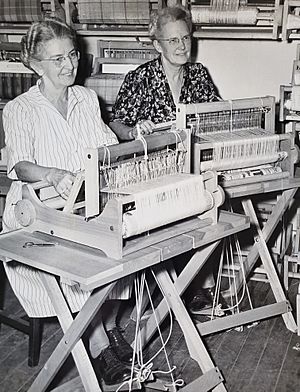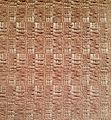Ada Dietz facts for kids
Quick facts for kids
Ada K. Dietz
|
|
|---|---|
| Born | October 7, 1888 Michigan
|
| Died | January 12, 1981 (aged 92) San Bernardino County California
|
| Resting place | Elmwood Cemetery |
| Nationality | American |
| Known for | Mathematics and fiber arts |
|
Notable work
|
Algebraic Expressions in Handwoven Textiles, 1949 |
Ada K. Dietz (born October 7, 1888 – died January 12, 1981) was an American weaver. She is famous for her book Algebraic Expressions in Handwoven Textiles, published in 1949. In this book, she shared a new way to create weaving patterns. Her method uses algebra to design beautiful fabrics.
Ada Dietz's ideas are still important today. Both weavers and mathematicians find her work interesting. She showed how math and art can come together in amazing ways.
Weaving with Algebra
Ada Dietz created her special algebraic weaving method in 1946. At that time, she was living in Long Beach, California. Ada loved weaving, and she used her past experience as a math teacher to come up with this idea.
How the Math Works
She based her weaving patterns on a math idea called a binomial expansion. This sounds complicated, but it's like a special way to multiply numbers with letters.
Ada explained her idea like this: "Imagine you have a math problem like (x + y) to the power of 3. I thought about it like a real-world math problem. I let x stand for one unknown thing and y for another."
"In weaving, x could mean the first two parts of the loom (called harnesses). And y could mean the third and fourth harnesses. Then, I just used the math formula to figure out how to thread the loom."
A Popular Idea
One of Ada's woven pieces was based on a longer math formula: (a + b + c + d + e + f) to the power of 2. She showed this piece at a fair in Louisville, Kentucky. People loved it!
This positive reaction led Ada to work with Lou Tate, who started the Little Loomhouse. Together, they created the book Algebraic Expressions in Handwoven Textiles. They also made a traveling exhibit that showed off Ada's unique weaving throughout the 1950s.
Images for kids



